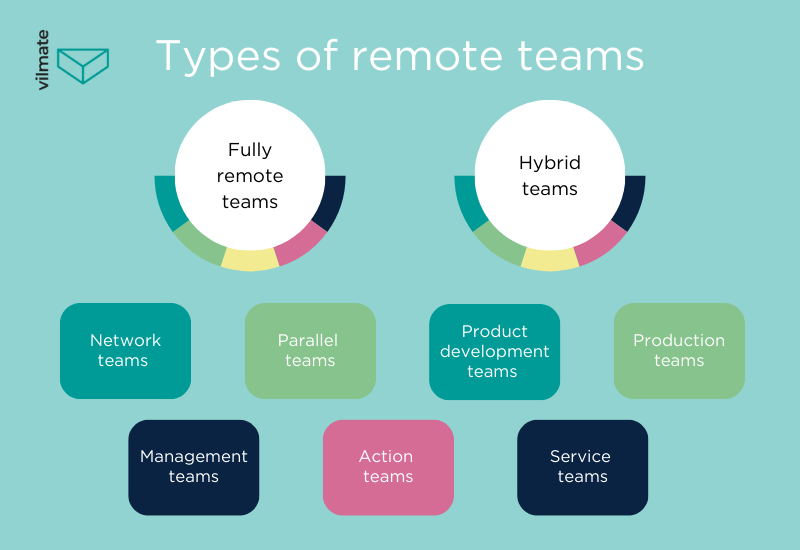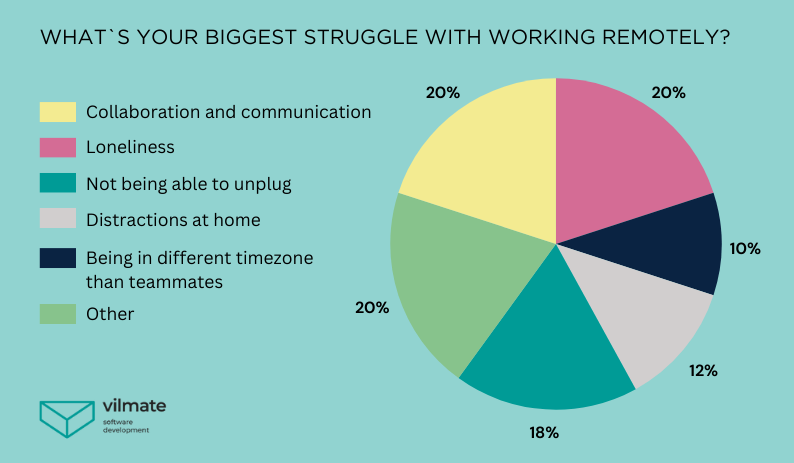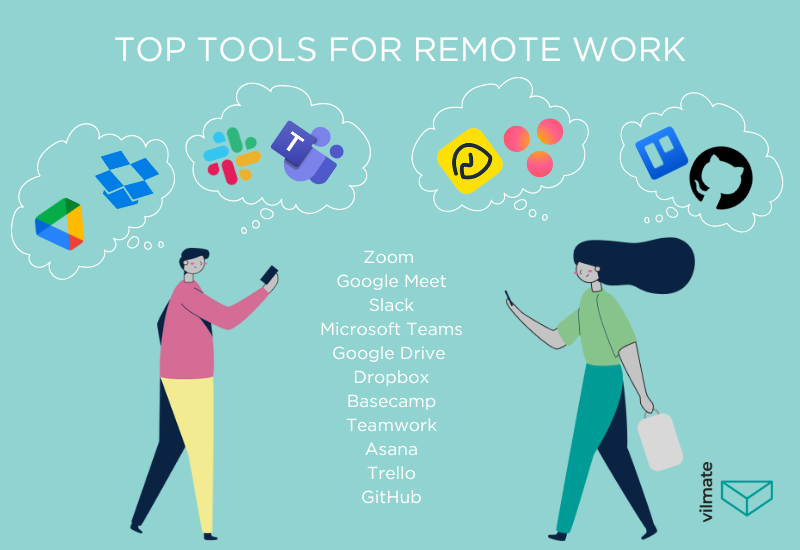The world's digital transformation continues, and remote communication has become a big part of our lives. We spend much time chatting online about various things, including work. Many teams of developers have switched to working entirely remotely, ditching offices and daily chats by the water cooler.
The COVID-19 pandemic significantly influenced the digitalization of work. Many individuals commenced working from home due to the inability to gather in person. And guess what? Many developers found it way more comfortable than going to the office every day. Employers who need people for projects also saw the benefits of working together remotely.
However, there are different opinions on remote work. Some employers doubt the ability of remote employees to stay focused and professional compared to those working in offices.
At Vilmate, we've been assembling remote teams of developers for various projects for 12 years. We're well-versed in the pros and cons of remote collaboration and can help determine whether it's the right fit for your business. Let's dive deeper into the world of remote developer teams and explore how to build the perfect working group.
What a Remote Team is
If you believe remote work is a recent phenomenon, you may be surprised to learn the truth. In reality, remote teams began to emerge in the 1990s, as evidenced by a report from McKinsey & Co. Companies like IBM recognized that significant cost savings could be achieved by eliminating permanent offices.
Since then, the popularity of remote work has grown significantly. Statistics have shown a 91% increase over the past ten years, and there are several reasons for this. However, before delving into the advantages and disadvantages, let's first clarify what a remote team of developers is.
A remote team is a group of individuals who work from different locations toward a common goal. Communication among remote employees occurs through online tools, while one or more remote managers oversee the work of various team groups.
There are several types of remote teams, each with variations in work structure.
Types of Remote Teams
Remote employees can be situated within the same city or across different continents. They may choose to operate within a single time zone or work independently on their schedules to meet deadlines.
The effectiveness of a distributed team relies heavily on seamless communication and the availability of high-quality work tools. These tools facilitate task management, enable conference calls, and facilitate file sharing.
There are two primary types of remote teams:
- Fully remote teams. These teams consist of geographically dispersed employees who cannot convene physically at any given time.
- Hybrid teams. This model incorporates remote employees and those who work intermittently in the office. Additionally, hybrid teams may include groups of employees situated in various offices who communicate with other departments via the Internet.

Types of remote teams can also vary based on the format of collaboration:
- Network teams assemble cross-functional specialists to exchange expertise and knowledge on specific issues. Membership in such teams is fluid: new participants can join as needed, and old ones can leave once their task is completed.
- Parallel teams are formed to address specific tasks within an organization. Members remain unchanged until the stated goal is achieved.
- Product development teams include experts from different locations to perform specific tasks, such as developing a new product.
- Production teams unite specialists in one field to carry out regular work. Each member has clearly defined responsibilities and works independently.
- Service teams comprise members working in different time zones. Each member's work continues the work of the previous one.
- Management teams bring together managers from different locations to discuss corporate-level strategies.
- Action teams are formed to respond quickly to urgent issues. Once the task is resolved, such a team is disbanded.
Indeed, you can devise a working format that fits a specific project. However, before proceeding, it's crucial to ensure that remote teams align with your business needs.
We'll delve into the advantages and disadvantages of remote teams that employers need to consider further.
Co-Located vs. Distributed Teams
Previously, we promised to explain the reasons behind the increasing popularity of remote work. The growth in the number of remote job vacancies, which reached 12.2% in 2023, was influenced by various factors, not limited to the pandemic. These include:
- A heightened desire to achieve a better work-life balance leads to an increased demand for remote work.
- The expansion of internet access and digital tools makes remote work more feasible and efficient.
- The labor market's globalization has opened up opportunities for collaboration and knowledge sharing in online formats.
- The development of online education and training promotes professional development and offers flexibility in choosing a work location.
- Trends toward reducing costs associated with maintaining physical offices and infrastructure prompt companies to adopt remote work models.
However, the fact that more employers hire remote development teams does not automatically mean that this format suits everyone.
Let's explore the benefits and drawbacks of co-located and distributed teams to compare the practicality of both models.
Advantages of co-located teams:
- Face-to-face meetings. You can convene regularly with all team members for discussions and brainstorming sessions. Meetings can be scheduled at any convenient time.
- Prompt access to information. Team members can quickly obtain answers to colleagues' queries without waiting for them to be available online. Moreover, during discussions, they can gain insights from casual bystanders or promptly initiate group discussions.
- Continuous engagement. Team members receive real-time updates and information, bypassing the need for mass or individual distribution.
Disadvantages of the office-centric approach:
- Limited diversity. Access to a diverse pool of talents and ideas is restricted due to geographical constraints.
- Dependency on location. Work operations may be disrupted by location-related issues, such as inclement weather or traffic congestion.
- Team size constraints. Larger teams with more than 10-15 members may need help maintaining effective face-to-face communication, even when co-located. A larger team doesn't necessarily translate to more efficient one-on-one collaboration.
When considering the advantages, the primary benefit is often streamlined communication. The simplicity of communication and the ability to monitor team members' progress frequently drive the preference for a co-located team.
Let's delve into the benefits provided by the districuted approach:
- Access to global talent. This advantage entails the capacity to attract highly skilled professionals from various parts of the world, fostering diversity and innovation within the team.
- Reduction in office infrastructure costs. Distributed teams do not necessitate permanent office space for all members, which is why companies can save on office rent and related infrastructure expenses.
- Extended working hours. Operating across different time zones enables distributed teams to offer continuous customer support or project services, enhancing customer satisfaction and the company's competitive edge.
- Increased employee satisfaction. The flexibility in work schedules and the option to choose their work location elevate employee satisfaction levels. This autonomy fosters a sense of control over their work environment, improving their overall quality of life and work-life balance.
Employees typically favor remote work, and research suggests that companies with remote teams experience a 25% lower turnover rate.
However, the primary drawbacks of remote teams often revolve around communication challenges. In a hybrid approach, remote employees may feel isolated and disconnected compared to their office counterparts.
You might assume that the primary challenge of remote work is that employees working from home tend to get distracted from their responsibilities by watching TV or playing with pets.
The Buffer survey reveals the opposite. According to the study, 18% of remote workers report struggling to disconnect from work even during non-working hours, dedicating more time to tasks than when they were in the office. Only 12% admitted to being distracted by household matters.
It's essential to recognize that creating a quiet and peaceful environment in the office, where nobody talks or types on keyboards, is much more challenging. Therefore, distractions are abundant in any work environment, and creating a secluded space for concentration at home is comparatively more straightforward.
Many surveyed workers agreed that loneliness (20%) and communication difficulties (20%) are the primary challenges of remote work.

Before deciding on the team format, consider the criticality of communication issues for your business. We'll discuss further considerations shortly.
How to Choose between Remote and Co-Located Teams
When deciding between co-located and distributed team management in software development, several factors must be considered.
Co-location is ideal when you want to focus on the creative process and establish closer connections between team members. Working in the same building promotes idea exchange and mutual understanding, facilitating collective thinking. Additionally, the absence of physical barriers simplifies communication and ensures a unified view of the project through visual aids. This model is also suitable for sensitive projects where control and accessibility are essential.
On the other hand, distributed teams are optimal for organizations aiming to scale and expand into the global market. This approach allows for the hiring experts worldwide and reduces office space costs. You gain access to a plethora of talent at affordable rates, fostering innovation and product development. However, successful collaboration relies on an understanding leader capable of motivating and inspiring the team remotely.
Ultimately, both models have advantages and are suitable for different scenarios. It's important to choose an approach that best aligns with your project's goals and characteristics while also providing support and motivation to team members, regardless of their location. Next, we'll provide you with four factors to help make the final decision.
1. Trust and Security
Trust and security form the cornerstone of successful collaboration, particularly in international team projects. When people work together in the same office, it's easier to control and ensure the security of data and processes. However, maintaining data security becomes more challenging when the team is spread across different countries.
If you're unsure whether your team can reliably ensure data security and adhere to all rules while working remotely, choose a co-location model. In this model, you have more control over processes and access to information, which can help mitigate potential risks.
2. Communication
Communication and information exchange are vital in software development, whether your team works together in the same office or across continents. Companies implementing modern digital communication tools can collaborate successfully with distributed developer teams.
On the other hand, if you work with a team concentrated in one location, you may need to configure your workspace to facilitate the free exchange of information and knowledge. It involves creating shared spaces for discussion and collaboration and using digital tools for effective communication and file sharing.
3. Business Size
When deciding whether to collaborate with co-located or distributed teams, consider the size of your business and the expectations for the investments made. Startups might prefer working with a team in one location initially, where they can more easily control processes and minimize potential issues.
Larger organizations with sufficient resources are increasingly considering a distributed development model. They can afford to hire specialized project managers and effectively coordinate the work of distributed teams to achieve maximum productivity and innovation.
4. Budget
A remote developer team will typically be more cost-effective. Firstly, you can hire specialists from less developed countries who provide high-quality services at relatively budget-friendly prices. Secondly, you won't have to spend money on real estate and its maintenance, reducing overhead costs.
Overall, remote work offers significant cost advantages if you want to and can manage work processes yourself. However, it is essential to weigh these benefits against potential communication and team management challenges.
Lastly, always consider the comfort of your developers. It's widely known that one of the most appealing options for talented individuals is remote work. By offering remote positions, you're more likely to attract highly skilled specialists from anywhere in the world. Many employees value a hybrid approach—where they can work from home yet still have the option to go to a comfortable office to focus on their tasks.
Suppose you're concerned that a virtual team of developers won't be able to function effectively without a manager constantly overseeing their work. In that case, we will further discuss methods to enhance the remote work experience.
Creating an effective Remote Development Team
There are many examples of successful companies where remote employees work efficiently. The process of transitioning to remote work is often called "Uberization," after Uber, which effectively manages independent contractors and freelancers worldwide.
One striking example is Automattic, the company behind WordPress. Despite having no physical office, it has brought together employees from 40 countries to work effectively.
To ensure the effectiveness of your remote team, you need to immerse yourself in the process. Proper management is key to optimizing task execution. You must either become a leader or delegate this responsibility to an experienced project manager.
Here are some tips to help you start working productively remotely:
1. Optimize your Workflow.
The best solution for a remote team is a digital platform where all the resources for effective collaboration are available. Developers should have access to tasks, mark progress, and have the opportunity to express their ideas.
2. Set clear Goals and Deadlines.
Remote workers should know what is expected of them and when tasks need to be completed. You can set performance metrics for the team to ensure motivation and easy results tracking.
3. Create a Corporate Culture.
Ensure that remote team members know each other and their colleagues' skills. It's also essential to get to know each employee personally, as you would in an office setting. Remember to share your own goals and values with the team. Regularly reward good work, as this approach helps keep employees motivated.
4. Facilitate regular Meetings.
Regular online meetings allow employees to stay involved, observe their colleagues' successes, and brainstorm ideas. To make communication productive, you must have an agenda. Meetings can be general or conducted with specific parts of the team. It is also crucial to allow employees to communicate one-on-one to discuss minor issues and ensure all stages are coordinated.
5. Provide maximum Freedom.
People appreciate remote collaboration's freedom and the opportunity to work during their "inspiration hours." Constantly hovering over developers and controlling their every move is unlikely to yield ideal results. We do not recommend forcing employees to track their work hours in Time Doctor or other tracking programs if they are not working hourly. Let employees work when it suits them, and this approach will lead to greater motivation and high-quality task execution. Set specific deadlines and get your desired results exactly when you want them.
If you've already decided to hire a remote development team for your project, it's essential to understand what employees it should consist of. Let's consider the key roles needed for a remote IT team.
Selecting the Right Team Members for your Remote Team
During the interview process, selecting motivated individuals who can organize themselves effectively is crucial. Ensure that candidates have previous experience with remote work and possess all the necessary tools for efficient task execution.
The specific roles in a remote IT team depend on the project's requirements. However, in a typical IT team, you may find:
- Backend, frontend, and/or full-stack developers
- QA engineers and automation testers
- Business analysts and system analysts
- UX/UI designers
- DevOps engineers (specialists in automation deployment and infrastructure management)
- Project managers
The key to building a successful remote IT team is selecting the right individuals with the required skills and ensuring effective communication and project management. You can choose from various tools to facilitate communication, which we'll discuss further.
Top Tools for Remote Work
First and foremost, you need tools that allow employees to communicate and exchange files quickly and efficiently. You can implement simple and popular platforms like Zoom or Google Meet. Alternatively, you can use more streamlined channels like Slack or Microsoft Teams.
You can use file-sharing platforms such as Google Drive and Dropbox to share documents and images. These cloud storage solutions allow you to upload large files that will be instantly accessible to all authorized team members.

If your team is adept at remote work, they may benefit from a project management platform that includes various remote work tools. The most popular platforms include Slack, Basecamp, Teamwork, Asana, and Trello.
GitHub is an indispensable tool for software developers to collaborate on code. It provides version control, the ability to collaborate on projects, and knowledge sharing within the developer community.
Final Thoughts
Remote developer teams offer an excellent collaboration format, enabling you to recruit top specialists globally while saving costs. However, establishing an effective remote team and setting up processes can pose challenges. This aspect can be delegated to professionals.
Vilmate specializes in creating efficient remote developer teams for both large-scale and minor projects. With over 150 top-notch specialists available who are masters of their craft and adept at remote work, we have extensive experience forming teams of 3-4 people with specialties tailored for various types of startups and ongoing projects.
Our employees can adapt flexibly to current processes, are proficient in multiple languages, and can work across different time zones. Additionally, we adopt a hybrid approach to team formation, allowing developers to convene in offices in Warsaw, Kharkiv, and Kyiv.
By choosing Vilmate, you can be confident in creating a conducive work environment and monitoring productivity. We are fully prepared to take on your project!




